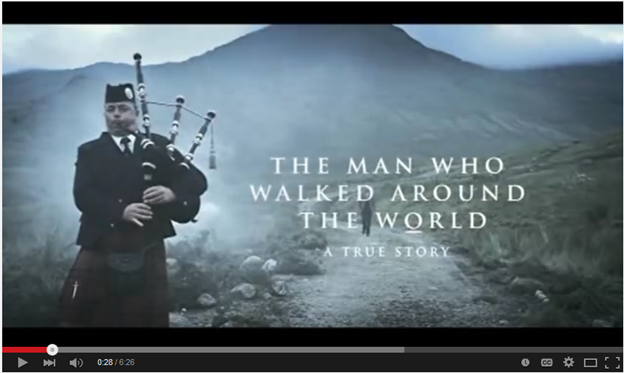
In the world of whiskeys, there are scotch whiskys, Irish whiskeys and then everyone else. In this market brand is not everything but it is almost everything. Few whiskeys exist with a bigger brand than Johnnie Walker. They have worked tirelessly to promote the idea of how Johnnie Walker is bigger than big yet at the same time, is personable and down to earth. In the video pictured above (https://www.youtube.com/watch?v=MnSIp76CvUI ), They have gone out of their way to tell you the story of how Johnnie Walker came to be. They make this story using a very clear rhetorical approach. Through the use of imagery, facts, and comedic relief, they weave an incredible tapestry.
The video opens with a solo piper on a hillside playing the pipes, we are instantly transported to the bog, standing next to him as he plays. As he plays we notice a man from the distance approaching, as he comes clearly into view, he shouts for the piper to “Shut It” and then proceeds to directly speaks to the viewer and eloquently tells the tale of Johnnie Walker. The approach is an example of the personalization principle in that his banter is specifically conversational, yet provides us the history of the brand from the beginnings of a young man opening a grocery in the hills of Scotland through the companies start in the Victorian age to where we know them today. As the guide walks along, images that add to the audio are brought into and out of focus quickly. This use of the contiguity approach helps accent and reinforce the audio and helps again to pull the viewer personally into the story as both the story teller and the viewer walk along interacting with the world we are viewing. Stepping through the grocery door, the bar with the brands on it, the guide pointing at a barrel while omitting the word from his speech for emphasis.
The video also showcases the segmentation principle in that as the story is unfolded, it is broken up into periods of time. The narration guides us along and smoothly segues into the next period by introducing the viewer to the next family members who contributed to the success of the brand. The segments also are visually queued by the narrator’s use of hats (i.e. 3:18, 3:48) , and later other props ( i.e. 4:06, 4:34), to help break apart the script into bite sized pieces that the viewer can digest as we walk along.
The video appeals to the viewer all three rhetorical appeals. It starts from an ethos approach in the use of a casually dressed, easy going narrator who converses along the journey with wit and an easy going conversation. He conveys his facts with authority of an expert while keeping it on a level that the viewer can appeal to.
The use of logos appeal is apparent in the list of facts and supporting details that are used to support the story being told. The facts support the story’s theme, are specific and detailed. This is demonstrated from 2:44 to 3:06 where the narrator explains the detailed reasoning behind the bottle shape and label design and the importance of both.
The appeal to Pathos carries across the whole video. The references to family, quality, and the use of inclusive language, draws the viewer into the brand and entices the viewer to be a part of the company’s slogan “Keep Walking.”
Through the use of a rhetorical approach and all three rhetorical appeals, Johnnie Walker creates a strong, lasting image of the brand in the viewer’s mind. The imagery and use of the narrator make the viewer feel like an inclusive part of an exclusive heritage.

 roughout the history of this country, there have been battle waged in the media to promote issues over other issues. Regardless of the issue, the use of images to promote their side has been used to great effect. The battle for hearts and minds over the move to Prohibition in 1918 was one where both sides of the aisle worked feverishly to swing the popular support for their side. The Temperance Movement, led by individuals such as Billy Sunday and in favor of prohibition sold the idea to the American Nation that alcohol was evil and would lead us into damnation and often used ads such as this one to convince the populous that their cause was just and righteous. This ad is a great example of the coherence principle and uses the rhetorical appeals of ethos and pathos.
roughout the history of this country, there have been battle waged in the media to promote issues over other issues. Regardless of the issue, the use of images to promote their side has been used to great effect. The battle for hearts and minds over the move to Prohibition in 1918 was one where both sides of the aisle worked feverishly to swing the popular support for their side. The Temperance Movement, led by individuals such as Billy Sunday and in favor of prohibition sold the idea to the American Nation that alcohol was evil and would lead us into damnation and often used ads such as this one to convince the populous that their cause was just and righteous. This ad is a great example of the coherence principle and uses the rhetorical appeals of ethos and pathos.